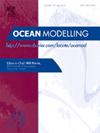飓风“厄玛”引发的沿海洪水后向图
IF 2.9
3区 地球科学
Q2 METEOROLOGY & ATMOSPHERIC SCIENCES
引用次数: 0
摘要
飓风“厄玛”在美国大约1500公里的海岸线上引发了沿海洪水,让许多人措手不及。非典型的风暴潮模式是由风暴演变的细微特征驱动的,当与海岸几何形状配对时,导致了广泛变化的风暴潮反应。本文利用ADCIRC+SWAN环流与波浪耦合模式和两组气象强迫(再分析和参数化模式)对Irma的沿海洪水响应进行了后发。这使我们既可以评估模型性能,又可以说明复杂浪涌响应背后的机制。艾玛沿着佛罗里达半岛的路径影响了西佛罗里达海岸的大部分地区以及从佛罗里达到南卡罗来纳州的东南大西洋沿岸的水位。我们发现沿西佛罗里达和东南大西洋海岸的水位响应的保真度与风速和风向的保真度密切相关。然而,从强烈的海上风向到强烈的陆上风向的快速变化,以及在佛罗里达州南部登陆位置附近产生的跨大陆架流,使得那里的水位反应对风暴的细节高度敏感。特别是,强烈的初始沉降产生了跨大陆架压力梯度,加强了风暴后侧陆上风驱动的浪涌,形成了类似共振的跨大陆架响应,可能进一步增强了浪涌。我们还评估了美国地质调查局风暴潮汐传感器数据产品的质量,这些数据已成为广泛使用的风暴相关水位数据来源。确定了几个误差来源,这些误差可以组合在一起,在处理过的水位数据中产生相当大的总体误差,而这些误差可能对用户来说并不明显。本文章由计算机程序翻译,如有差异,请以英文原文为准。
A hindcast of coastal flooding from hurricane Irma
Hurricane Irma produced coastal flooding across roughly 1500 km of U.S. coastline that caught many by surprise. The atypical surge patterns were driven by nuanced characteristics of the storm’s evolution that, when paired with the coastal geometry, led to a widely varied storm surge response. Here, we perform a hindcast of the coastal flooding response to Irma with the coupled ADCIRC+SWAN circulation and wave model, and two sets of meteorological forcing, one a reanalysis and the other a parametric model. This allows us to both assess model performance and to illustrate the mechanisms behind the complex surge response. Irma’s track along the length of the Florida peninsula affected water levels along much of the west Florida coast as well as the southeast Atlantic coast from Florida to South Carolina. We find the fidelity of the water level response along much of the west Florida and the southeast Atlantic coasts closely tracks the fidelity of the wind speed and direction. However, the rapid change from strong offshore to strong onshore winds and resulting across-shelf flow near the location of landfall in southern Florida makes the water level response there highly sensitive to the details of the storm. In particular, the strong initial setdown created a cross shelf pressure gradient that reinforced the surge driven by onshore winds on the back side of the storm in a resonant-like cross shelf response that may have further enhanced the surge. We also assess the quality of U.S. Geologic Survey storm tide sensor data products, which have become a widely used source of storm-related water level data. Several sources of error are identified that can combine to yield a sizeable overall error in the processed water level data that may not be apparent to users.
求助全文
通过发布文献求助,成功后即可免费获取论文全文。
去求助
来源期刊

Ocean Modelling
地学-海洋学
CiteScore
5.50
自引率
9.40%
发文量
86
审稿时长
19.6 weeks
期刊介绍:
The main objective of Ocean Modelling is to provide rapid communication between those interested in ocean modelling, whether through direct observation, or through analytical, numerical or laboratory models, and including interactions between physical and biogeochemical or biological phenomena. Because of the intimate links between ocean and atmosphere, involvement of scientists interested in influences of either medium on the other is welcome. The journal has a wide scope and includes ocean-atmosphere interaction in various forms as well as pure ocean results. In addition to primary peer-reviewed papers, the journal provides review papers, preliminary communications, and discussions.
 求助内容:
求助内容: 应助结果提醒方式:
应助结果提醒方式:


